Midweek Review
State of national economy, scandalous SUV order and fuel price hikes
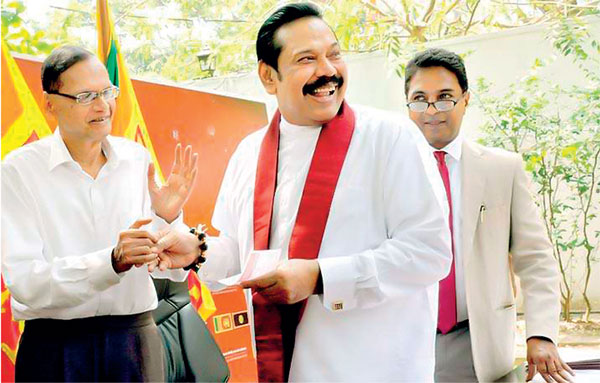
A smiling PM Mahinda Rajapaksa takes SLPP membership from SLPP Chairman Prof. G.L. Peiris in late 2018 at the former’s Wijerama Mawatha residence while Sagara Kariyawasam, General Secretary of the Party, now embroiled in simmering controversy, looks on.
Trade Minister says Prez does not bring money from Mirihana or PM from Medamulana
By Shamindra Ferdinando
What is the current state of the economy? How can the public determine the state of the economy? Let me briefly refer to recent statements made, both in and outside Parliament, by members of the ruling Sri Lanka Podujana Peramuna (SLPP) on the state of the economy. The issue, at hand, is whether the incumbent government is competent to cope up with the situation.
Trade Minister Bandula Gunawardane (SLPP/Colombo District), Energy Minister Attorney-at-Law Udaya Gammanpila (PHU/Colombo), Urban Development and State Minister of Coast Conservation, Waste Disposal and Community Cleanliness Dr. Nalaka Godahewa (SLPP/Gampaha District) lucidly explained ground realities. They painted an extremely bleak picture. Perhaps, they haven’t done so intentionally, to place the government in a difficult situation. However, their assessment certainly underscores the responsibility on the part of the government to review its strategies, without further delay.
Twelve years after the conclusion of the war against terrorism, the national economy is in tatters. The deterioration of the economy cannot be entirely blamed on the rampaging global pandemic, Covid-19.
Political parties may seek to take cover behind the pandemic, conveniently forgetting how waste, corruption, irregularities and negligence withered the economy. Obviously, the pandemic has accelerated the decay and the government is in an unprecedented crisis. Vast majority of people are struggling to make ends meet against the rapidly worsening situation.
Those responsible (both UNP and SLFP members of Parliament in the 2015-2019 yahapalana administration cannot absolve themselves of the responsibility) for Treasury bond scams, perpetrated in Feb 2015 and March 2016, are now advising the SLPP on how to manage the economy. Interestingly, the SLFP is a constituent of the ruling SLPP, whereas those who stood with the Treasury bond thieves, now represent the Samagi Jana Balavegaya. There is never a dull day in utterly corrupt Sri Lankan politics.
‘Government unable to bear continuing losses’
Lawmaker Gammanpila made two damning statements as regards the state of the economy – at the Energy Ministry, on June 3, and at another briefing, at the same venue, on June 11. Unfortunately, the former Jathika Hela Urumaya (JHU) heavyweight’s critical comments didn’t receive sufficient media attention.
Addressing the media, on June 3, at his Ministry, Minister Gammanpila admitted that heavily debt ridden and cash-strapped government and the Ceylon Petroleum Corporation (CPC) weren’t in a position to procure USD 3 bn loan (USD 3,000 mn) required for a new oil refinery at Sapugaskanda. Therefore the funding required for what Minister Gammanpila described as the country’s largest single project to be carried out following competitive bidding had to be external investment (read outside the government).
Declaring that the proposed refinery project will be the biggest ever industrial venture undertaken, Minister Gammanpila declared that all major previous undertakings had been carried out, sans competitive biddings. The declaration was made after he admitted that altogether the Hambantota port (USD 1,350), Norochcholai coal-fired plant (USD 900mn), the Mattala airport, and the Colombo-Katunayake highway, cost USD 2,916, whereas the proposed Sapugaskanda refinery project is estimated to cost a staggering USD 3,000mn. PHU leader Gammanpila’s admission there hadn’t been competitive bidding, in respect of previous major projects, is nothing but an indictment of the previous Rajapaksa administration, or the system in place.
Minister Gammanpila’s declaration that the Ceylon Petroleum Corporation Act (No. 28 of 1961) would have to be amended to pave the way for USD 3 bn investment, triggered accusations the government was planning to privatize the state venture. The lawmaker described the proposed Sapugaskanda project as a BOT (Build, Operate and Transfer) basis enterprise with it reverting to Sri Lankan ownership once the investor recoups his investment.
The ministerial claim that the government refrained from increasing fuel prices for 21 months is a grim reminder the public cannot expect the truth from politicians. Or did they keep quiet expecting a miracle rescue like their earlier faith in Dhammika Peniya (syrup) and the hocus-pocus of pouring contents of some earthenware containers into a river to tackle the pandemic?
At the June 11 briefing, Minister Gammanpila commented on the imminent fuel price increase, in addition to the proposed Sapugaskanda project. Gammanpila explained that the government’s inability to bear further losses against the backdrop of the pandemic driven collapse of the tourism sector, halt in foreign investment, sharp drop in foreign remittances, hence the hiking of the fuel prices with the world market price of crude topping USD 70 per barrel. The Minister declared that it would be quite a challenge to procure the required fuel, amidst the foreign exchange crisis.
Responding to strong JVP criticism of the Sapugaskanda project, Minister Gammanpila pointed out that the USD 3 bn estimate was based on a pre-feasibility report, prepared before him being appointed the Energy Minister. The forthright politician declared that once they finalized feasibility study a better understanding of the project could be had.
The bottom line is that the country lacked wherewithal to undertake a major infrastructure project.
Total collapse of revenue sources professed
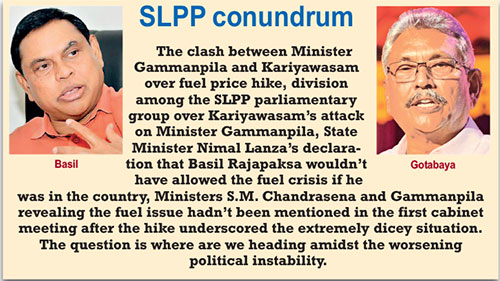 State Minister Dr. Godahewa, during an inspection tour, on June 09, of Sarakkuwa and Dungalpitiya areas badly affected by the sinking of the fire-ravaged X-Press Pearl container carrier, didn’t mince his words when he explained the state of the national economy. Dr. Godahewa, who had served the private sector quite efficiently, before turning to party politics, explained the pathetic state of the national economy. What he said was simply frightening. Assuring the SLPP’s commitment to provide relief to those who had been affected, Dr. Godahewa declared that one fourth of state revenue had been spent on ongoing efforts to bring the Covid-19 epidemic under control. Dr. Godahewa asserted that the government faced the prospect of total collapse of state revenue. The State Minister’s assertion cannot be taken lightly.
State Minister Dr. Godahewa, during an inspection tour, on June 09, of Sarakkuwa and Dungalpitiya areas badly affected by the sinking of the fire-ravaged X-Press Pearl container carrier, didn’t mince his words when he explained the state of the national economy. Dr. Godahewa, who had served the private sector quite efficiently, before turning to party politics, explained the pathetic state of the national economy. What he said was simply frightening. Assuring the SLPP’s commitment to provide relief to those who had been affected, Dr. Godahewa declared that one fourth of state revenue had been spent on ongoing efforts to bring the Covid-19 epidemic under control. Dr. Godahewa asserted that the government faced the prospect of total collapse of state revenue. The State Minister’s assertion cannot be taken lightly.
Making reference to Rs. 5,000 relief allowance paid to selected groups of people, on four occasions, the former Chairman of the Securities and Exchange Commission estimated that so far the government spent over Rs 250 billion for Covid-19 control/relief work.
Trade Minister Gunawardane, too, bitterly complained about the state of the economy in Parliament. His June 8 speech, in the relatively empty Parliament, underscored the pathetic situation. The government seemed quite helpless and in a deepening dilemma over the absence of wherewithal to meet daunting challenges. In his own way, Minister Gunawardane admitted that public finance was in quite a distressing position. The COPE (Committee on Public Enterprises), COPA (Committee of Public Accounts) and COPF (Committee on Public Finance) should take tangible remedial measures to redirect Sri Lanka’s from its disastrous path.
In spite of making quite horrendous revelations about waste, corruption, irregularities and negligence, the parliamentary watchdog committees haven’t been able to bring runaway corruption under control. Those who had been exposed at COPE proceedings continue in their nefarious activities with impunity. The national carrier, SriLankan Airlines is a case in point. In last week’s column, titled ‘How public sector corruption withers national economy: RJ’s insight,’ the writer dealt with the late Rajeewa Jayaweera’s damning reportage of the national carrier. RJ left SriLankan Airlines, in 2005, not in 1995, as inadvertently mentioned. RJ’s brother, Sanjeewa Jayaweera (SJ) brought the error to the writer’s notice. But, what really interested me was SJ’s observation that the report of the Presidential Commission of Inquiry (PCoI) on SriLankan Airlines, Mihin Air et al prepared following 12 months of sittings during yahapalana rule hasn’t been released, nor any action initiated against the wrongdoers.
RJ’s 41 articles on the national carrier revealed how those who managed the SriLankan Airlines and political authority defied laws of the land and continue to do so. The accumulated losses suffered by the national airline now stand at a staggering Rs. 326 bn with the two-state banks – BOC and People’s Bank – continuing to bear the losses.
Minister Gunawardane explained the country’s economic woes, bluntly. Acknowledging that the national economy was in dire straits and if budget shortfall couldn’t be met, through domestic and foreign loans, there was no option but to sell-off assets. Having compared how a government and a family struggled to manage shortfall income, the former reputed economics tuition master recommended selling of national assets. The SLPP certainly owed an explanation whether Minister Gunawardane articulated its position.
Minister Gunawardane told the stark truth to the House that neither Prime Minister Mahinda Rajapaksa, who was also the Finance Minister, nor President Gotabaya Rajapaksa would bring money from Medamulana or Mirihana to solve the unprecedented financial woes facing the country. Emphasizing the responsibility of Parliament, in respect of public finance, Minister Gunawardena emphasized 225 members of Parliament (regardless of political parties they represented) were responsible for taxpayers’ money.
Sharp hike in fuel price amidst Covid time bonanza
Minister Gammanpila’s Friday announcement, on fuel price hike, came as quite a surprise. That move flabbergasted the public, as much as the shameless decision to procure 228 Toyota Land Cruisers did in late May. Of the 399 vehicles ordered, 225 were for members of Parliament, made up of SLPP 145, SJB 54, TNA 10, JJB 3 (JVP contested under the JJB banner), AITC 2, EPDP 2, UNP 1, SLFP 1 and OPPP, TMVP, MNA, TMTK, ACMC, NC and SLMC one each. Among the beneficiaries is the sole UNP National List member though yet to take oaths as an MP. Obviously super luxury Toyota Land Cruisers are ordered for 225 members of Parliament. If so, the government should reveal the lucky recipients of the three remaining SVUs. Such luxury vehicles for lawmakers, at a time the country is experiencing severe economic difficulties, cannot be justified under any circumstances. Now JVP leader Anura Kumara Dissanayake has questioned the rationale in ordering SUVs for 225 members, the JVP should ask the Secretary General of Parliament Dhammika Dasanayake whether the three JVPers, in Parliament, were included in the list of those destined to receive brand new vehicles. Did the Finance Ministry submit a Cabinet paper that dealt with 399 vehicles, including those intended for MPs without seeking their approval? The JJB parliamentary group comprised Anura Kumara Dissanayake, Vijitha Herath and Dr. Harini Amarasuriya.
The contentious issue at hand is whether the Finance Ministry placed an order for SVUs for MPs without asking the consent of all members of Parliament, representing 15 recognized political parties?
Media Minister and co-Cabinet spokesperson Keheliya Rambukwella is on record as having said that though the Prime Minister’s Office announced the cancellation of the 399 vehicle order, against the backdrop of financial difficulties caused by the Covid-19 pandemic, the government may not be able to do so because Letters of Credit had already been opened. Amidst the growing public anger over the squandering of public funds to acquire luxury vehicles for MPs, Minister Rambukwella, on June 11, declared that the Finance Ministry, and other parties to the Rs 3.7 bn transaction, following successful negotiations, has cancelled the vehicles for lawmakers.
It would be pertinent to mention that the Prime Minister’s Office on May 20 indicated the impending fuel price hike. A statement issued by the Prime Minister’s Office said that the government was seriously concerned about the rising price of crude oil in the world market from 2020 and an upward revision was imminent.
However, what really stunned the public was General Secretary of the SLPP Attorney-at-Law Sagara Kariyawasam questioning the fuel price hike. National List MP Kariyawasam asked whether the unexpected increase was meant to undermine the SLPP administration. The MP faulted Energy Minister Gammanpila for the situation.
Hiru presenter Chamuditha Samarawickrema last Sunday (13) ridiculed lawmaker Kariyawasam’s declaration. Samarawickrema, who had been recently embroiled in a controversy over make-up artist Chandimal Jayasinghe and Public Security Minister, retired Rear Admiral Sarath Weerasekera, having functions at the Shangri-La hotel, on May 30 and May 28, respectively urged MP Kariyawasam not to stage dramas.
The Hiru anchor questioned Kariyawasam’s accusation that Minister Gammanpila did so to cause trouble for the government.
The government obviously is in deep trouble. It should explain why such expensive SUVs were ordered for lawmakers, in May, against the backdrop of the rapid deterioration of the nation’s financial position. The country got to know of the despicable decision to place an order for SVUs only after the Prime Minister’s Office through a public announcement claimed to have cancelled in the fourth week of May.
CPC saves USD 300 mn
COPE, PAC and COPF proceedings, since the last general election, revealed waste, corruption, irregularities and negligence. Inquiries that had dealt with public sector enterprises over the past two decades, exposed public-private sector partnerships in utterly wasteful and corrupt practices. So much so that today’s financial crisis cannot be examined without taking into consideration extremely poor management of state enterprises, and public and private sector cooperation, at the high level, to rob the country. Two such glaring examples are the Treasury bond scams, perpetrated in 2015 and 2016, by the Yahapalana administration, and the massive sugar tax scam, carried out by the SLPP. The JVP is on record as having alleged that the sugar tax scam is far worse than even the Treasury bond scams. The high profile sugar scam couldn’t have been executed without the issuance of gazette bearing No 2197/12 dated Oct 13, 2020 by the Finance Ministry. That resulted in the immediate replacement of Rs 50 duty on a kilo of imported sugar with a mere 25 cents. In spite of COPF Chairman lawmaker Anura Priyadarshana Yapa’s declaration, on January 05, 2021 that the consumers didn’t benefit at all from duty reduction the government has conveniently forgotten the matter. The SLPP should be ashamed of its role in such corrupt practices.
Perusal of proceedings of COPE, COPA and COPF underscored those in political authority as well as officials who ruined the national economy. As the writer mentioned before, the ruination of SriLankan Airlines is just one example. Both the SLFP and the UNP ruined the national carrier in style is certainly nothing to be surprised about. They dealt with all state sector enterprises in a similar way. The way procedures have been manipulated to rob the country is another story. Proceedings in respect of procurement of coal required by Norochcholai revealed unprecedented corruption. But, absolutely nothing has been done. No action whatsoever has been taken against corrupt elements, though shocking revelations have been made in Parliament.
Would you believe the statements issued by the Prime Minister’s Office and Energy Minister Gammanpila, as regards the status of crude oil prices, were contradictory? However, the Communication Department of Parliament recently revealed that the CPC saved USD 300 mn in 2020 due to the drop in crude oil prices in the world market as well as some other factors. This came to light during COPE proceedings, thanks to a query raised by SJB member S.M. Marikkar.
Midweek Review
Impact of US policy shift on Sri Lanka
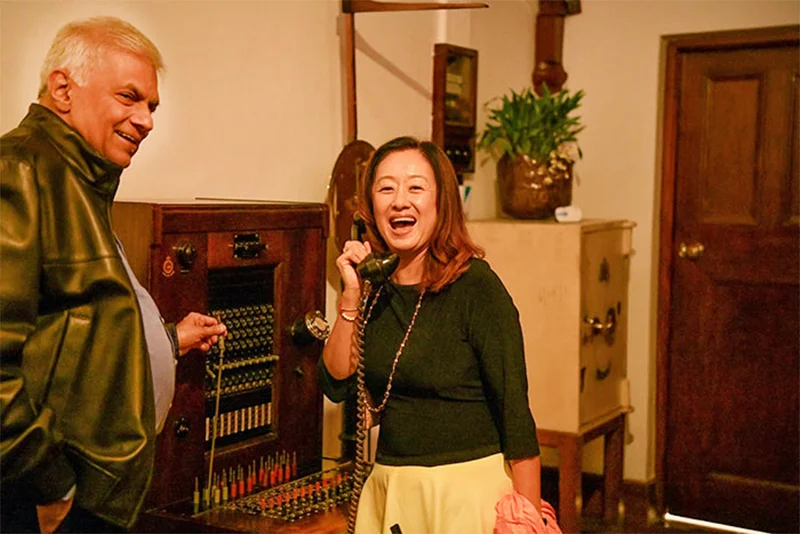
President Trump has unceremoniously overturned US foreign policy. His decision to deport illegal Indian migrants just ahead of a summit with Premier Narendra Modi, underscored the tough stance taken by the new US admiration. The much-touted US-India strategic partnership didn’t deter Trump from carrying out the much-publicized humiliating deportations of Indians. US Vice President J.D. Vance’s speech at the Munich Security Conference, recently, indicated that Trump has terminated his special relationship with Europe and is charting his own course. The upcoming Trump and Russian leader Putin’s meeting stressed that the US policy wouldn’t be shaped by European concerns over Russia. Against that background, the US is very much unlikely to pursue the Biden policy as regards bankrupt Sri Lanka. Actually, Sri Lanka’s political leadership will have to do some serious thinking and re-examining our position as Trump redraws US foreign policy.
By Shamindra Ferdinando
Since the successful conclusion of the war in mid-May 2009, despite all the naysayers, and even the likes of the then British Foreign Secretary David Milliband and French Foreign Minister Bernard Kouchner, rushing here at the eleventh hour with the hope of getting President Mahinda Rajapaksa to halt the offensive to enable them to evacuate the LTTE supremo, his family and their surviving fanatical terrorist band to safety abroad, the US appointed five Ambassadors to Colombo. Of them four were women, namely Patricia A. Butenis, Michele J. Sison, Alaina B. Teplitz and incumbent Julie J. Chung. Between the tenures of Sison and Teplitz, the only male Atul Keshap, of Indian origin, served here for a period of four years (Aug. 2015-July 2018) during the Yahapalana administration.
Ambassador Chung oversaw President Gotabaya Rajapaksa’s forced ouster in 2022. In spite of her denial, Amb. Chung’s role in President Rajapaksa’s removal is clear and cannot be disputed. Amb. Chung will soon be replaced by Elizabeth Kathryn Horst, currently the Principal Deputy Assistant Secretary and Deputy Assistant Secretary responsible for Pakistan, yet another country in which Washington is mired in regime change operations in the region.
Amb. Chung presented her credentials on Feb. 25, 2022, to President Rajapaksa, at the Janadhipathi Mandiraya. The President was flanked by State Foreign Minister Tharaka Balasuriya and Presidential Secretary Gamini Senarath. The new US envoy took office close on the heels of a major crisis within the government that compelled the President to ask for his Secretary Dr. P.B. Jayasundera’s resignation. Just five weeks after Amb. Chung took over the mission, the ‘GotaGoHome’ campaign got underway and a President, elected with over 6.9 mn votes on the SLPP ticket, was thrown out of office within four and half months by violent mobs armed with meticulous intelligence as to which politicians’ houses were to be ransacked and torched, along with those of their close supporters in a matter of a few hours, especially on May 09, 2022. Exactly two months later they completed their despicable mission by storming the Presidential palace.
The SLPP, both in and outside Parliament, accused Amb. Chung of staging the ouster of President Gotabaya Rajapaksa. Award-winning author Sena Thoradeniya (Galle Face Protest: System Change or Anarchy) and (Nine: The Hidden Story) by National Freedom Front (NFF) leader Wimal Weerawansa, MP, dealt with Amb. Chung’s sordid involvement.
However, the writer believes that the whole exercise should be examined as another arrogant US intrusion rather than Amb. Chung’s private agenda. Her job was to do the bidding of Washington. Let me stress that the US made a serious but an abortive attempt to bring President Mahinda Rajapaksa’s reign to an end in 2010. Thanks to Wikileaks we know how the US used a UNP-led coalition, that included the wartime LTTE ally the Tamil National Alliance (TNA), and the JVP, to back retired General Sarath Fonseka at the presidential election. That gamble failed. The war-winning Army Chief ended up with egg on his face with an unforgettable thrashing from the overwhelming southern electorate.
Eyebrows were raised when the outgoing American envoy recently expressed her desire to meet Sri Lanka Podujana Peramuna (SLPP) leaders at the Nelum Mawatha party office as she never bothered to do so since her arrival in early 2022.
Contrary to speculation, the outgoing US Ambassador had sought a meeting about two weeks ago before the unprecedented public exposure about the USAID’s (United States Agency for International Agency) sinister operations here and worldwide in the wake of the new US administration deciding to curtail drastically its operations for being a white elephant as America itself is being confronted with a fast developing and yet to be fully fathomed economic crisis, which might even exceed the worldwide Great Depression that came with the 1929 stock market crash. On her arrival at Nelum Mawatha last Friday (14) Amb. Chung was received by SLPP General Secretary and Attorney-at-Law Prasad Kariyawasam. The SLPP delegation was led by its National Organizer Namal Rajapaksa and one of the three lawmakers in the current Parliament. Having accused her of being in the thick of the regime change, the SLPP’s readiness to meet Amb. Chung, too, is a mystery.
It would be pertinent to briefly explain the USAID’s global objectives as the vast majority wrongly believed the agency is meant for humanitarian work. It is definitely not a charity. Its main objective is to strengthen capabilities of US agents, or assets, at local and regional levels regardless of the status of Washington’s relationship with the targeted country.
These agents, or assets, are available for the US at any time as Washington desired. Pentagon, the State Department or even the Central Intelligence Agency (CIA) used its resources under whatever circumstances. If we closely examine the pattern of USAID operations, as well as other related organizations that had been active here over a period of time, even our legislature is within the sphere of their influence. In other words, they obviously have direct access to politicians and officials who wield power over key institutions. The private sector, too, became part of the US operation carefully expanded countrywide.
By the time Amb. Chung arrived here. US assets were in place at different levels ready to carry out directives. Those who pointed a finger at Amb. Chung never bothered to examine the background and comprehend the gradual build-up that allowed the gathering of all elements, under the social media fuelled ‘GotaGohome’ campaign.
The US mission here had done a tremendous amount of work, especially beginning with the Amb, Keshap’s time, to enhance the capacities of their existing assets and identify and develop new assets.
What really prompted Amb. Chung to suddenly seek a meeting with the SLPP? Did National List MP Namal Rajapaksa’s call for the setting up of a Parliamentary Select Committee (PSC) to probe USAID funding, influence her decision? But that cannot be as the US Embassy made the request before the USAID controversy. Perhaps, SLPP General Secretary Kariyawasam expressed concern over Amb. Chung’s frequent visits to the JVP headquarters at Pelawatte, whereas she ignored the SLPP.
Appearing on a live television programme, Kariyawasam pointed out that Amb. Chung had plenty of time for the JVP, a party with just three MPs, while the SLPP, in spite of being represented by 145 MPs, never received the US envoy’s attention.
Perhaps Amb. Chung didn’t really feel the requirement to visit Nelum Mawatha as she maintained a close contact with the SLPP founder Basil Rajapaksa.
Ambiguity over objectives
It would be pertinent to ask both the sponsors and recipients whether various foreign-funded projects achieved their objectives.
The following are some of the USAID-funded projects launched, beginning 2017: [1] USD 19 mn social cohesion and reconciliation project implemented by Global Communities (July 2018-Dec, 2023) [2] Analysis of social cohesion and reconciliation implemented by US Institute of Peace at a cost of USD 700,000 (Aug. 2018-Feb. 2024) [3] USD 15 mn project implemented by Chemonics International Inc. to strengthen the justice sector, including the Justice Ministry and Office of Attorney General (Sept. 2021-Sept. 2026) [4] USD 17 mn project carried out by National Democratic Institute, International Republican Institute and International Foundation for Electoral System in support of Parliament and other government institutions, including the Election Commission (June 2020 – June 2024) [5] USD 14 mn worth project in support of civil society meant to achieve good governance reforms and strengthen accountability. Implemented by Management Systems International (Feb. 2018-Aug. 2024) [6] USD 7.9 mn scheme to strengthen media implemented by International Research and Exchanges Board Inc. (Aug. 2017-April 2023) [7] SAFE Foundation implemented a programme at a cost of USD 3.9 mn aimed at combating human trafficking (Oct. 2021-Sept. 2026) [8] USD 1.6 mn project to enhance protection for those threatened by gender-based violence (Oct. 2021-Sept. 2026). Implementing agency Women-in-Need [9] USD 3.6 mn project for the benefit of plantation community implemented by Institute of Social Development (June 2022-June 2027) and [10] a staggering USD 19 mn project meant to strengthen the civil society by unnamed private agencies (Sept. 2022-August 2027).
Interestingly, high profile USAID operations implemented in collaboration with successive governemnts covered the Justice sector (Justice Ministry and Office of Attorney General), Parliament as well as the Election Commission.
Over the years USAID with a massive budget that even exceeded the CIA’s and allied organizations have built up a system that served the interests of the US. That is the truth. Sri Lanka has cooperated not only with the US but other organizations, such as the UNDP, to allow them influence in Parliament. The USAID and UNDP have ‘secured’ Parliament by lavishly spending funds on various projects. In spite of spending millions in USD with the 2016 agreement between Parliament and USAID being the single largest project, what they have achieved here is nothing but a mystery.
Successive governments have encouraged USAID, UNDP and other interventions. They felt happy as external sources provided the funding. Let me give an example of how the UNDP stepped-in for want of sufficient public funding for vital government initiatives. Sometimes, they advanced their political project in the guise of helping the government of the day.
On May 13, 2021, the then Attorney General Dappula de Livera, PC, opened the USAID funded state-of-the-training facility that included a boardroom, auditorium, computer laboratory, and other facilities. The outspoken AG also launched an electronic system to track cases and legal files. The launch of the training facility, electronic diary and file management system, and the Attorney General’s Department website were also attended by Supreme Court Judge Justice Yasantha Kodagoda P.C., Acting Solicitor General Sanjay Rajaratnam P.C., the Secretary of the Ministry of Justice M.M.P.K. Mayadunne, and virtually by DCM Kelly and USAID Mission Director Reed Aeschliman.
The US Embassy, in a statement issued on that quoted AG Livera as having said: “This is another first in the 136-year history of the Attorney General’s Department. The opening of the training centre is a notable, salutary achievement that meets a long-felt need for continuous learning and professional development.” The AG was further quoted as having said these new tools would “drive the institution from strength to strength.”
If such facilities were so important why on earth the Attorney General’s Department failed to take tangible measures to meet that particular requirement.
Those who demand investigations into USAID must realize that their role is much more complicated than alleged and reported in some sections of the media. Among the beneficiaries were the Sri Lanka Judges’ Institute.
American Corner in Jaffna
The US Embassy established an American Corner in Jaffna with the collaboration of Jaffna Social Action Centre (JSAC), an NGO that particularly promoted women and children rights. Formed in 2003 in the North as the Liberation Tigers of Tamil Eelam (LTTE) was preparing to launch Eelam War IV, JSAC, over the years, developed into a recipient of US funding. JSAC is among the groups promoting LGBTQ in the Northern and Eastern Provinces. JSAC annually participates in the much-touted 16 Days of Activism Against Gender Based Violence campaign. The then US Ambassador Butenis attended the opening of the American Corner. JSAC, in its website, has revealed an impressive list of partners and donors.
Perhaps JSAC should explain how it served the interests of ordinary people, especially during the 2003-2009 period when the LTTE stepped up forcible recruitment of children, including girls. Forced conscription continued unabated as the military slowly but steadily rolled back the LTTE fighting formations, towards the east coast, until they were trapped in a sliver of land in the Mullaitivu district.
Sri Lanka should be grateful for US assistance over the past decades. The ordinary people benefited from such help but later Washington weaponized the setup as various interested parties queued up to secure lucrative contracts.
Amb, Chung, in late Sept. 2022, moved the American Centre in Colombo, that had been in existence for over seven decades, to the new US Embassy building. This was a couple of months after Aragalaya (March – July 2022) forced Gotabaya Rajapaksa out of office. The American Centre in Colombo had been first located at the Millers Building in Colombo, then at Galle Face Court, followed by Flower Road, before moving to the Sri Ramya at 44, Galle Road.
The American Corner in Kandy was established in 2004. In addition to Jaffna, Colombo and Kandy, there are similar facilities in Matara and Batticaloa.
The recent declaration by Bharatiya Janata Party MP Nishikant Dubey, in the Indian Parliament, that the USAID had been funding organisations with a view to creating unrest cannot be ignored. The BJP’s declaration underscored the gravity of the situation. Those who discarded repeated accusations by National Freedom Front (NFF) leader Wimal Weerawansa as regards US interventions here must take a fresh look at the developments taking place since Donald Trump’s return for a second term.
Dubey alleged the USAID funded organizations that carried out protests against the Agniveer initiative of the government, backed caste census, and supported Naxalism in India.
On behalf of the BJP, Dubey asked for a probe into whether Congress and the Gandhi family-controlled Rajiv Gandhi Foundation had received USAID funds through George Soros’ Open Society Foundations (OSF) for conducting activities, including the campaign for a caste census and against the Agniveer scheme introduced by the government. The MP claimed OSF received ₹5,000 crores from USAID to “break up India”. He raised the issue during zero hour.
The BJP MP’s accusations seemed somewhat surprising as India, under Narendra Modi’s leadership, established close relations with Washington and is a member of the four-country Quad, comprising the US, Australia, Japan and India meant to counter Chinese expansion.
Why subvert India? Is the question in everybody’s mind? President Trump, during a joint press conference with Premier Modi, speculated about the possibility of USAID role in the Lok Sabha elections last year. Perhaps Trump is playing politics even at the expense of the US as he sought to dismantle USAID.
The Trump administration has imposed a global stop-work directive on USAID, suspending most aid initiatives, except for critical food relief programmes.
However, India, too, had been blamed for interfering in internal affairs of other countries. Recently Canada alleged that India intervened in its electoral process. Canada named China as the other offender. India has strongly refuted the Canadian allegation. It would be pertinent to mention that Canada had been playing politics with Sri Lanka for many years as major political parties sought to exploit the post-war developments for their advantage. New Delhi also accuses Canada of encouraging Khalistan separatists operating from there.
Canadian Parliament, in May 2022, unanimously declared that Sri Lanka perpetrated genocide in a bid to appease Canadian voters of Sri Lanka origin.
The expansion of the USAID project here should be examined against the backdrop of Geneva adopting a US accountability resolution, co-sponsored by the treacherous Sirisena-Wickremesinghe government in 2015. The US backed Sirisena’s candidature at the 2015 presidential election. That was in line with their overall strategy to end the Rajapaksas rule, perceived to be China-friendly. The US funded the 2015 UNP-led campaign that involved the TNA and JVP as well. A group of civil society groups, led by the National Movement for Social Justice (NMSJ), backed Sirisena’s candidature, who switched sides at the last moment having been in the Rajapaksas camp throughout his political career and it was done after having a hopper feed with them the previous night.
Having betrayed his own party in 2014, Sirisena has ended up politically irrelevant. That is the price the one-time SLFP General Secretary had to pay for switching sides for personal gain. The former President is most unlikely to get an opportunity to re-enter Parliament ever again.
The NPP will have to be cautious how it handles the situation against the backdrop of developing political and economic upheaval in Washington as we may have never seen hitherto. The way the new administration addressed much more complicated issues, such as the Russia-Ukraine war in a manner seriously inimical to the European powers and pullout from the Geneva-based UNHRC and WHO meant that Trump has already turned US foreign policy upside down.
Midweek Review
Revisiting Humanism in Education:
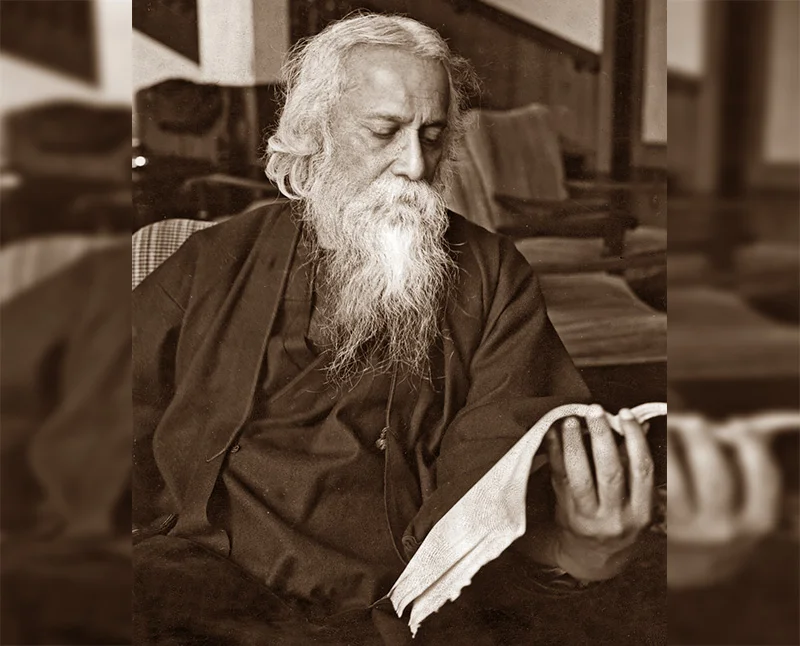
Insights from Tagore – III
by Panduka Karunanayake
Professor in the Department of Clinical Medicineand former Director, Staff Development Centre,
University of Colombo
The 34th J.E. Jayasuriya Memorial Lecture
14 February 2025
SLFI Auditorium, Colombo
(Continued from18 Feb.)
Tagore had an important answer to the question of whether the economic or the political should enjoy the primacy of place, in designing educational policy. He said: “Economic life covers the whole base of society, because its necessities are simplest and the most universal. Educational institutions, in order to obtain the fullness of truth, must have close association with this economic life.”
Sometimes I have difficulty understanding why Tagore, in spite of his appreciation of science and disdain for superstition, still lavishly exalted his traditional dieties and the scriptures. I think he did so because he saw a remarkable practical utility in them for the organisation of society and because they carried innumerable lessons for human conduct – for which science and technology, or even modern administration, had not yet furnished any suitable alternative.
Besides, it is clear that he admired religion’s potential to bring peoples together. In The Religion of Man, he wrote: “On the surface of our being we have the ever-changing phases of the individual self, but in the depth there dwells the Eternal Spirit of human unity beyond our direct knowledge.” But of course, religion seldom brought humanity together. And whenever it played the divisive role, he did not blindly follow its precepts.
The stickiest issue in India for the modern philosopher is probably its caste system, and Tagore had no qualms about repudiating it:
“…differentiation and separation of vocations and trades, professions and callings on which the caste system originally rested has become totally extinct and it is altogether impossible to maintain it any longer. Yet all the taboos, external restrictions and customs associated with the varna system are still in place, static and intact. It seems we must put up with the cage with all its iron bars and fetters though the bird for which it was made is dead and gone. We provide bird feed every day but no bird feeds on it. In this way, due to the cleavage between our social life and social customs, we are not only being inhibited and obstructed by unnecessary, outmoded arrangements, we cannot live up to our professed social ideals, either.”
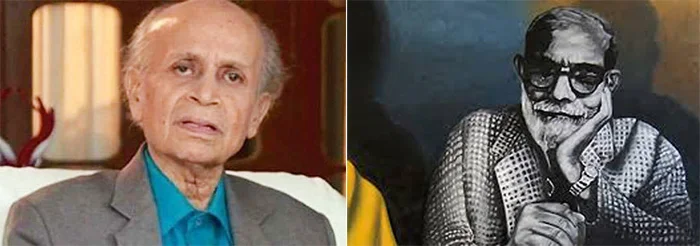
Prof. Carlo Fonseka / Dr. Abrahm T. Kovoor
I wish that for our country, we could replace the phrase ‘caste system’ with our own ‘outmoded arrangements’ – such as astrology, superstitious rituals and harmful so-called healing practices – and carefully re-read that quote. Sadly, our populace is filled with superstition, myth and pseudoscience – as a cursory glance at the supplements of any weekend Sinhala newspaper would show. Here, the high literacy rate actually works against the nation! Our public intellectuals must also take the blame, because they have failed to sustain the good work that had been done in the 1970s by intellectuals like Dr E.W. Adikaram, Abraham Kovoor and Professor Carlo Fonseka.
Another interesting point in his ideas is his desire to see education as a tool for everyone, not just the educated few. Reminding us on ancient Indian education and learning, he said:
“There was a regular traffic between specialised knowledge and ordinary knowledge. Scholars, pundits or learned society did not have an antithetical relationship with the less learned segments of society…There was hardly a place in the country where the Ramayana, the Mahabharata, the Puranic myths and religious discourse did not spread in a variety of ways. Even the theoretical philosophical issues which were rigorously, relentlessly discussed and debated in philosophy and metaphysics always filtered down to the mind of the people…In those days learning was the asset of the entire society and not the acquisition of the learned few.”
In our own country, in contrast, I wonder whether expanded access to education has had a similar effect. In spite of decades of education in swabhasha and wide access to education, knowledge is a tool of separation, seclusion and self-aggrandisement for the few who win the lottery. Is this the fault of the education or the educated? Perhaps both. The educated use their learning as a weapon rather than as a tool to serve, a manifestation of the fierce competitiveness and the fixed mindset that pervades the successful products of our education. At the same time, as Tagore pointed out, it is the fault of education too:
“The rains of our education are falling a long distance away from where the roots of our whole life lie…Our ordinary daily life has no use for the education we acquire…It is unjust to blame this on students. Their world of books and the world in which they live everyday are poles apart…That is why it is seen that the same person who has formidable erudition in European philosophy, science and ethics tenaciously clings to the age old superstitions…We are no more amazed when we see that on the one hand he is separately enjoying literature full of varied sentiments while on the other he is busy only with making money…”
These are a few fundamentals that can be gleaned from Tagore’s second phase. They aren’t many, and perhaps they aren’t as earth-shattering as one might expect. But I feel that they are exactly what we are lacking today and prevent education from playing a nation-building role. If we can get these right, we actually need to get very little else right.
Phase 3: ‘Freedom from bondage’
Tagore’s role and position as an unrepentant internationalist at the time when India was demanding swaraj is well known. He was opposed to nationalism, and in fact correctly identified colonialism itself as a manifestation of the nationalism of the British – so he asked, if one were anti-colonialist, how could one be nationalist also?
But his internationalism was not a rootless existence floating aimlessly in the air. He was clear that one must be rooted in one’s own soil, strongly and firmly – it is from here that one must reach out to the wealth of the world. In another beautiful simile, he urged us not to fear the wind, and to open the windows of our house to let that wind in. He would assure us that we would be able to retain the good that the wind blew in and get rid of the bad. He also said that as long as our house had a firm foundation, the wind will not blow it away. So for him, the first step of being an internationalist is studying one’s own soil and placing a firm foundation for one’s existence. He admired and studied tradition without being a traditionalist.
With regard to Indian universities of his day, he lamented the fact that these were European grafts and nothing like India’s ancient intellectual heritage, such as Nalanda, Wikramshila or Takshasila. He lamented the type of intellectual this would produce. He wrote in 1932:
“We receive European learning as something static and immutable and consider it the height of modernity to cull and recite sentences from it. For this reason we lack the courage to reconsider it or think about it from a new angle. Our universities have nothing to do with and are cut off from the acute questions, dire necessities and extreme hardship facing the people of the country…Like parasites our mind, attached to text books, has lost its ability to find its food and invent by itself.”
These words seem no less relevant to our own universities, 90 years after they were written.
Tagore’s belief in internationalism and its effect on his philosophy of education is captured by his description of Visva-Bharati, the higher education institute he set up in 1921 using the Nobel Prize money: “Visva-Bharati represents India where she has her wealth of mind which is for all. Visva-Bharati acknowledges India’s obligation to offer to others the hospitality of her best culture and India’s right to accept from others their best.”
Conclusion
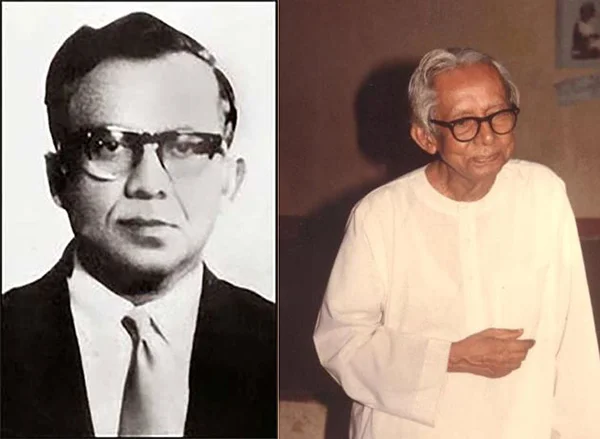
Prof. J. E. Jayasuriya / Dr. E. W. Adhikaram
Ladies and Gentlemen: I am afraid time would not permit me to cover the whole breadth of Rabindranath Tagore’s complete educational philosophy, and I wouldn’t even pretend to cover it in depth. For example, I didn’t touch on other important aspects that Tagore spoke of, such as school administration, advice for teachers, maintaining discipline without corporeal punishment, carrying out research and promoting creativity, women and education and so on. Forgive me for only scratching the surface. But the topic of Tagore’s educational philosophy is so vast that nothing wider would be possible in a short time.
You will also note that my talk was not filled with anecdotes of incidents and peculiarities at Santiniketan – like how classes were conducted under trees or how the gurudev once conducted a class in the rain for cattle when the students didn’t want to come out and get wet. These are not the timeless substance of the tale; they are only its time-sensitive ornaments.
If, on the other hand, I have been able to whet your appetite for his educational philosophy, and also convinced you that he had patiently worked on and presciently invented an antidote to today’s problems of education, I would be content for now. Balance was his antidote. My goal this evening was to place the seeds of his ideas in your minds, and hope that they will grow, be nourished and be pruned and manicured into a contextually appropriate shape in the months or years to come.
Selected bibliography
Dasgupta, U. (2013). Rabindranath Tagore: A Biography. Oxford University Press. (Translated by hiisß ckl l=udr- mßj¾;l (2024).rúkaøkd;a ;df.da¾-udkj ksoyi iy úúO;ajh kqf.af.dv iriú m%ldYlfhdaව)
Dore, R. (1976). The Diploma Disease: Education, Qualification and Development. London: George Allen & Unwin (republished in 1977 by Institute of Education, University of London).
Gunasekara, P. (2013). moaud .=Kfialr – kkaofiak .%duSh wOHdmk l%uh^1932-1939) lkakka.r;=udf.a wu;l l< fkdyels w;ayod ne,Sula fld<U iQßh m%ldYlfhda: කන්නunasekara, S.P. (2012). iuka mqIamd .=Kfialrම(2012). rúkaøkd;a ;df.da¾ fld<U tia f.dvf.aසහiyifydaorfhda(Basedon Rabindranath Tagore: The Myriad Minded Man (1995) by Krishna Dutta and Andrew Robinson, and other works.)
Illich, I. (1970). Deschooling Society. USA: Harper & Row (republished in 1973 by Penguin Education, Harmondsworth, England).
Iyengar, K.R.S. (1987). Rabindranath Tagore: A Critical Introduction. London: Oriental University Press.
Kripalani, K. (1961). Tagore: A Life. New Delhi: National Book Trust, India (author publication, republished in 1971 by National Book Trust, India).
Maithra, S., translator (2014). Education as Freedom: Tagore’s Paradigm. New Delhi: Niyogi Books.
Navaratnam, R. (1958). New Frontiers in East-West Philosophies of Education. Calcutta: Orient Longmans.
Neogy, A.K. (2010). Santiniketan and Sriniketan: The Twin Dreams of Rabindranath Tagore. New Delhi: National Book Trust, India.
Samuel Ravi, S. (2024). Philosophical and Sociological Bases of Education (2nd edn). Delhi: PHI Learning. (Chapter 13: ‘Rabindranath Tagore’, pp. 163-179.)
Sarathchandra, E.R. de S. (1942). ‘Through Santiniketan eyes’. Kesari People’s Weekly (Jaffna) serialised from 2(9) to 2(17) and compiled by Goonetileke, H.A.I., also available translated to Sinhala ^iqpß; .ï,;a-mßj¾;l ප(2001). ශYdka;s ksfla;kfha weiska fld<U tia f.dvf.a iy ifydaorfhda).
Venn, G. (1965). Man, education and work. In, Cosin, B.R., editor: Education: Structure and Society. Harmondsworth: Penguin Books. (Chapter 6, pp. 97-107.)
Venn, G. (1971). Preparation for further preparation (editorial). Educational Leadership 1: 339-341.
Midweek Review
Posy for the Unsung
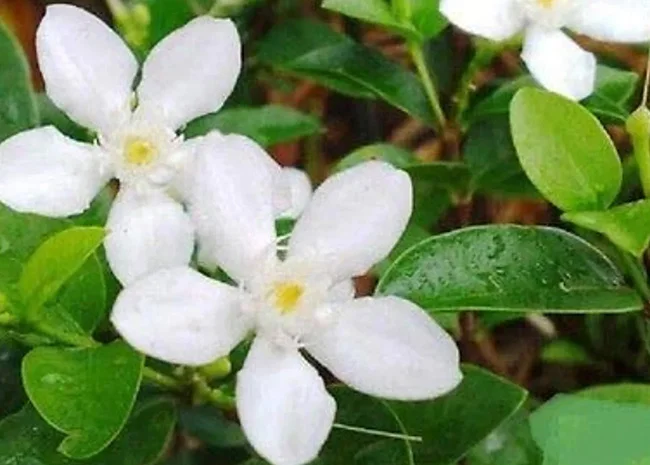
By Lynn Ockersz
You may call it a pilgrimage,
This yearly trudge she undertakes,
A posy of dainty flowers in hand,
To a rock-pile on a secluded hill,
Reeking of the graveyard’s silence,
Which covers her son’s remains,
Whom they bound and whisked away,
With dozens of other angry young men,
To a high place where elders say,
They were made to dig their graves,
At the point of smoking Ak-47 guns,
But all that scores of mothers such as her,
Have earned for their long nights of pain,
Are yellowing number tags for the missing,
Issued within stone walls of official silence.
-

 Sports5 days ago
Sports5 days agoRemarkable turnaround for Sri Lanka’s ODI team
-
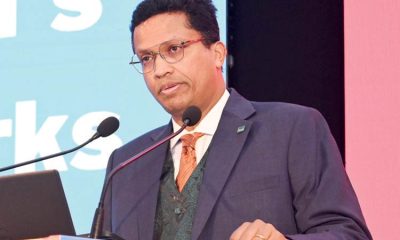
 Business5 days ago
Business5 days agoUN Global Compact Network Sri Lanka: Empowering Businesses to Lead Sustainability in 2025 & Beyond
-
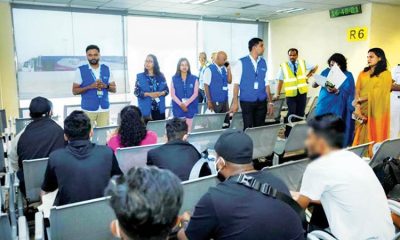
 Features5 days ago
Features5 days agoScammed and Stranded: The Dark Side of Sri Lanka’s Migration Industry
-
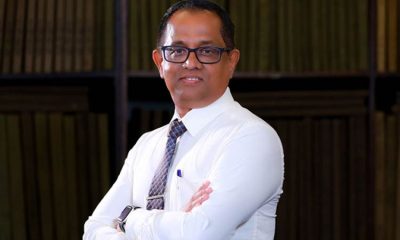
 News6 days ago
News6 days agoSpeaker agrees to probe allegations of ‘unethical funding’ by USAID
-
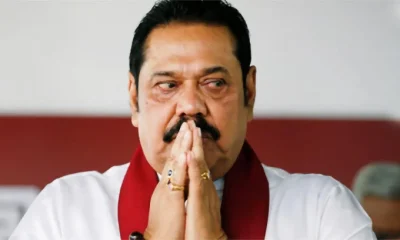
 Features4 days ago
Features4 days agoDon’t betray baiyas who voted you into power for lack of better alternative: a helpful warning to NPP – II
-
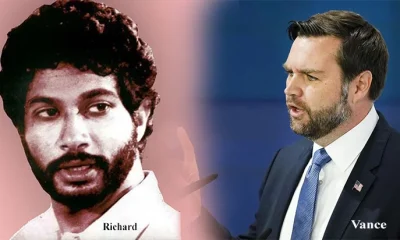
 Features4 days ago
Features4 days agoTwo films and comments
-

 Features7 days ago
Features7 days agoClean Sri Lanka and Noise Pollution (Part II)
-

 Editorial6 days ago
Editorial6 days agoCoal giant awakes, but uncertainty prevails











